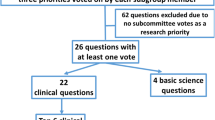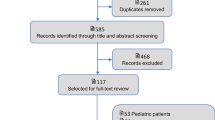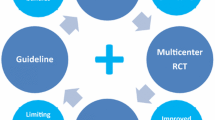Abstract
Objective
To assess multicentre, randomised, controlled trials (MC-RCTs) of systemic inflammatory response syndrome (SIRS) and sepsis conducted in Japan, published in Japanese and not available to English-language medical databases.
Design
Methodological review.
Subjects
All Japanese RCTs relevant to SIRS and sepsis.
Intervention
Identification of manuscripts using a Japanese electronic library. Critical analysis of methodology and reporting quality using a modified Methodological Quality Assessment Score and the CONSORT group check list.
Measurements and results
Three MC-RCTs were identified. In the first, 147 patients with septic shock were randomised to methylprednisolone (1000 mg i.v.) or placebo. In the second, 221 patients were randomised to 0.20 mg/kg per h or 0.004 mg/kg per h of sivelestat for acute lung injury with SIRS. In the third, 504 patients were randomised to immunoglobulin (5 g for 3 days) or to a control group. The average methodological quality score was higher than that of equivalent Western trials. The reporting quality (CONSORT checklist) was comparable to Western studies published during the same period.
Conclusions
Despite sound methodology and quality, the information obtained from relatively large Japanese critical care trials is not widely available to English-speaking investigators and therefore might be ignored in meta-analyses.
Similar content being viewed by others
References
Evidence Based Medicine Working Group (1992) Evidence based medicine: a new approach to teaching the practice of medicine. JAMA 268:2420–2425
Cook D, Sackett DL, Spitzer WO (1995) Methodologic guidelines for systematic reviews of randomized controlled trials in health care from the Potsdam Consultation on meta-analysis. J Clin Epidemiol 48:167–171
Kellum JA, Decker MJ (2001) Use of dopamine in acute renal failure: a meta-analysis. Crit Care Med 29:1526–1531
Kellum JA, Angus DC, Johnson JP, Leblanc M, Griffin M, Rmakrishnan N, Linde-Zwirble WT (2002) Continuous versus intermittent renal replacement therapy: a meta-analysis. Intensive Care Med 29:29–37
Lefering R, Neugebauer EA (1995) Steroid controversy in sepsis and septic shock: a meta-analysis. Crit Care Med 23:1294–1303
Cronin L, Cook DJ, Carlet J, Heyland DK, King D, Lansang MA, Fisher CJ Jr (1995) Corticosteroid treatment for sepsis: a critical appraisal and meta-analysis of the literature. Crit Care Med 23:1430–1439
Kopp R, Kuhlen R, Max M, Rossaint R (2002) Evidence-based medicine in the therapy of the acute respiratory distress syndrome. Intensive Care Med 28:244–255
Brower RG, Ware LB, Berthiaume Y, Matthay MA (2001) Treatment of ARDS. Chest 120:1347–1367
Graf J, Doig GS, Cook DJ, Vincent JL, Sibbald WJ (2002) Randomized, controlled clinical trials in sepsis: has methodological quality improved over time? Crit Care Med 30:461–472
Moher D, Schulz KF, Altman DG (2001) The CONSORT statement: revised recommendations for improving the quality of reports of parallel-group randomized trials. Ann Intern Med 134:657–662
Altman DG, Schulz KF, Moher D, Egger M, Davidoff F, Elbourne D, Gotzsche PC, Lang T (2001) The revised CONSORT statement for reporting randomized trials: explanation and elaboration. Ann Intern Med 134:663–694
Yamamura H, Tamakurma S, Ogawa R, Nakajima M (1992) The effect of methylprednisolone succinate for septic shock. Igakunoayumi 163:857–871
Tamakuma S, Shiba T, Hirasawa H, Ogawa M, Nakajima M (1998) A dose adjusting study of ONO-5046-Na for lung injury associated with SIRS. Rinshoigaku 14:263–288
Tamakuma S, Shiba T, Hirasawa H, Ogawa M, Nakajima M (1998) A phase III clinical study of a neutrophil elastase inhibitor; ONO-5046-Na in SIRS patients. Rinshoigaku 14:289–318
Masaoka T, Hasegawa H, Takaku F, Mizoguchi H, Asano S, Ikeda Y, Urabe M, Shibata A, Saito H, Okuma M, Horiuchi A, Saito Y, Ozawa N, Usami M, Ohashi Y (2000) The effect of immunoglobulin as a combination treatment with antibiotics for severe infection. Nihon kagakuryohogakkai zasshi 48:199–217
Ogawa R, Fujita T (1982) A scoring for quantitative evaluation of shock. Jpn J Surg 12:122–125
American College of Chest Physicians/Society of Critical Care Medicine Consensus Committee (1992) Definitions for sepsis and organ failure and guidelines for the use of innovative therapies in sepsis. Chest 101:1658–1662
Murray JF, Matthay MA, Luce JM, Flick MR (1988) An expanded definition of the adult respiratory distress syndrome. Am Rev Respir Dis 138:720–723
Alejandria MM, Lansang MA, Dans LF, Mantaring JBV (2003) Intravenous immunoglobulin for treating sepsis and septic shock (Cochrane Review). In: The Cochrane Library, Issue 1, 2003. Oxford: Update Software
Boldt J, Muller M, Mentges D, Papsdorf M, Hempelmann G (1998) Volume therapy in the critically ill: is there a difference? Intensive Care Med 24:28–36
Garcia-de-Lorenzo A, Ortiz-Leyba C, Planas M, Montejo JC, Nunez R, Ordonez FJ, Aragon C, Jimenez FJ (1997) Parenteral administration of different amounts of branch-chain amino acids in septic patients: clinical and metabolic aspects. Crit Care Med 25:418–424
Spies CD, Reinhart K, Witt I, Meier-Hellmann A, Hannemann L, Bredle DL, Schaffartzik W (1994) Influence of N-acetylcysteine on indirect indicators of tissue oxygenation in septic shock patients: results from a prospective, randomized, double-blind study. Crit Care Med 22:1738–1746
Burgess A, Comparet M, Doyle M, Foote L, Heine C, Howard C, Jones S, McKelvey D, Wright S (2003) The Economist Pocket World in Figures 2003. Profile Books, London, pp 26–27
Phu NH, Hien TT, Mai NT, Chau TT, Chuong LV, Loc PP, Winearls C, Farrar J, White N, Day N (2002) Hemofiltration and peritoneal dialysis in infection-associated acute renal failure. N Engl J Med 347:895–902
Day NPJ, Phu NHP, Bethell DP, Mai NTH, Chau TTH, Hien TT, White NJ (1996) The effects of dopamine and adrenaline infusions on acid-base balance and systemic hemodynamics in severe infection. Lancet 348:219–223
Mustafa I, Leverve XM (2002) Metabolic and hemodynamic effects of hypertonic solutions: sodium-lactate versus sodium chloride infusion in post-operative patients. Shock 18:306–331
Author information
Authors and Affiliations
Corresponding author
Additional information
This study was supported by the Austin Hospital Anaesthesia and Intensive Care Trust Fund.
Rights and permissions
About this article
Cite this article
Bellomo, R., Uchino, S., Naka, T. et al. Hidden evidence to the West: multicentre, randomised, controlled trials in sepsis and systemic inflammatory response syndrome in Japanese journals. Intensive Care Med 30, 911–917 (2004). https://doi.org/10.1007/s00134-004-2196-6
Received:
Accepted:
Published:
Issue Date:
DOI: https://doi.org/10.1007/s00134-004-2196-6




